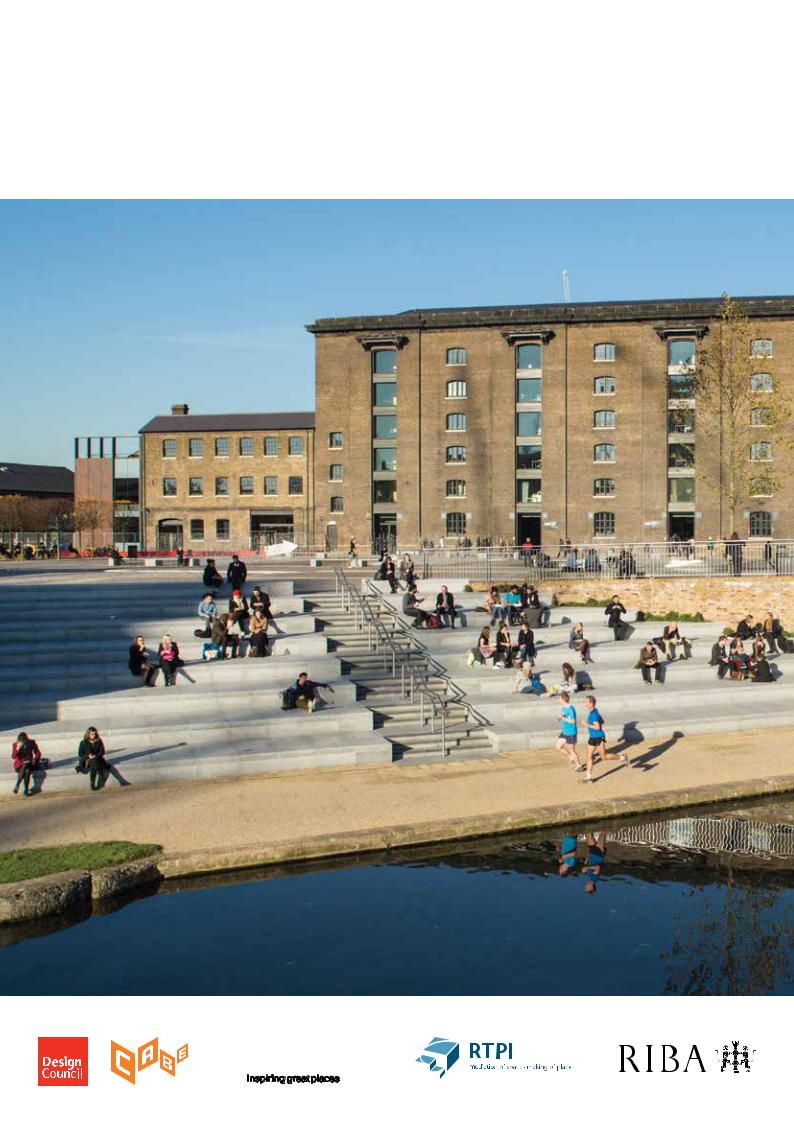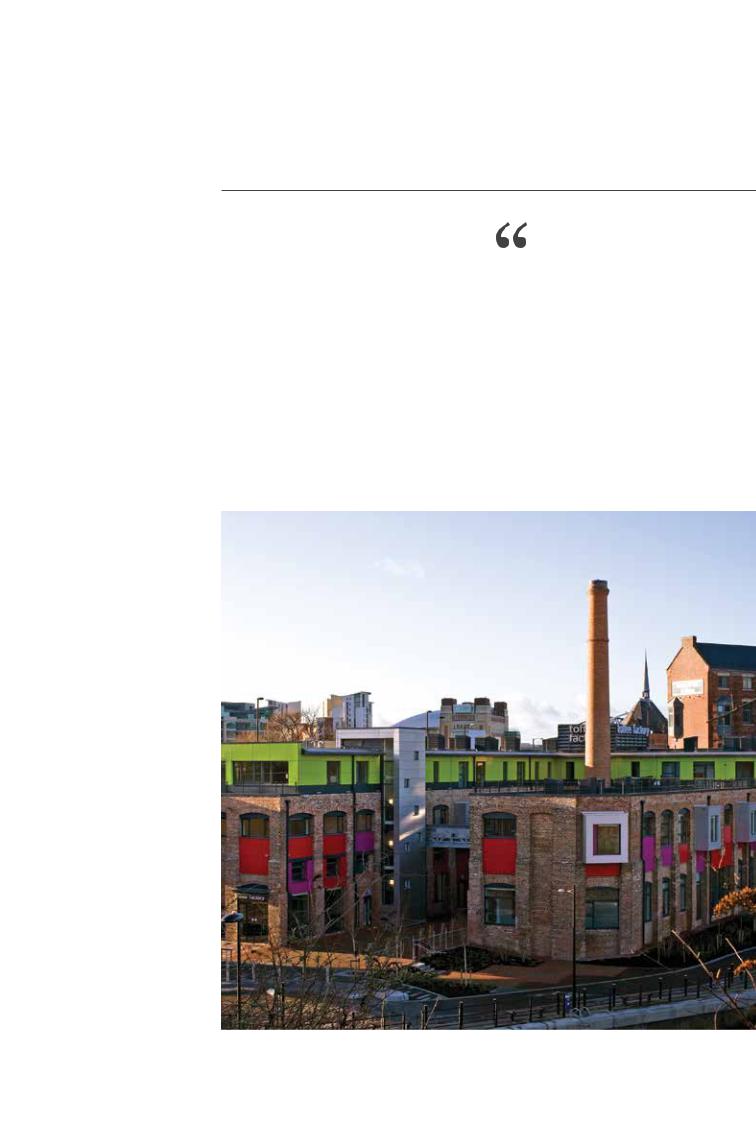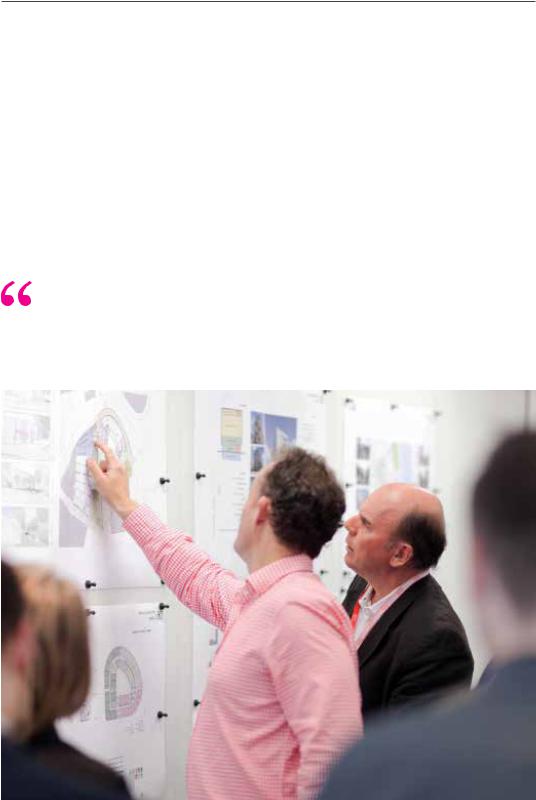
attachment_8
.pdf
Design Review
Principles and Practice
Landscape
Institute
Inspiringgreatplaces
Published in 2013 by the Design Council.
Cover photo: Granary Square at King’s
Cross, © John Sturrock
Inside back photo: William Gates Building, University of Cambridge, © RMJM
All photos by Design Council unless otherwise stated.
Although every care has been taken in preparing this report, no responsibility or liability will be accepted by Design Council, its employees, agents or advisors for its accuracy or completeness.
All rights reserved. No part of this publication may be reproduced, stored in a retrieval system, copied or transmitted without the prior written consent of the publisher except that the material may be photocopied for non-commercial purposes without permission from the publisher.

Contents
Foreword |
2 |
The purpose of this guidance document |
3 |
Part One: Principles of Design Review
Chapter 1: The essentials of Design Review |
5 |
What is Design Review? |
5 |
Ten principles of Design Review |
6 |
Chapter 2: The role of Design Review in the planning system |
7 |
Design Review and national planning policy |
7 |
How Design Review adds value |
8 |
Chapter3:WhobenefitsfromDesignReview? |
9 |
Local authorities |
9 |
Developers |
9 |
Project design teams |
10 |
Community groups |
10 |
Chapter 4: Local and National Design Review |
11 |
Local Design Review arrangements |
11 |
National Design Review |
11 |
Who reviews what? |
11 |
Part Two: Design Review in practice |
|
Chapter 5: Delivering the principles |
13 |
Chapter 6: A robust Design Review process |
22 |
Preparation |
22 |
Review |
24 |
Observers |
25 |
Advice |
26 |
Other practical matters |
27 |
Useful contacts |
28 |
Contents 1

Foreword
Our standards of design can be so much higher. We are a nation renowned worldwide for creativeexcellence,yet,athome,confidencein development itself has been eroded by the too frequent experience of mediocrity.”
Ministerial Foreword, National Planning Policy Framework
Every new development has the potential to transform people’s quality of life, stimulate the economy and enhance the environment. Each year local authorities see thousands of new proposals which have the power to do just that, to create better quality places.
Design Review is a tried and tested method of promotinggooddesignandisacost-effective andefficientwaytoimprovequality.Itoffers independent, impartial advice on the design of new buildings, landscapes and public spaces.
Design Review is now an essential part of the planning process. The publication of the National Planning Policy Framework (NPPF) re-iterated and reinforced the role of Design Review in ensuring high standards of design.
Design Review also plays a vital role in helping local authorities meet their statutory duty under the Planning Act 2008, ‘to have regard to the desirability of achieving good design’.
The Design Council, Landscape Institute, Royal Institute of British Architects and Royal Town Planning Institute have come together to update Design Review: Principles and
Practice following the assent of the Localism Act and publication of the National Planning
Policy Framework. It is aimed at anyone who is engaged in setting up or managing design review panels and anyone who receives their advice. It contains authoritative advice for
Design Review panels of all types to help them operate in a consistent way working to the 10 principles for good Design Review, as set out on page 6.
Design review panels – groups of leading multidisciplinary built environment experts – provide an independent, expert assessment of significant development proposals.
Well-managed Design Review panels help to achieve high quality schemes that add value to the places in which they are built. Panels operate across England at all levels and give access to all those using the planning system to high-quality independent design advice.
Put simply, Design Review promotes good quality developments that help create better places and avoid the cost of poor design.
John Mathers |
Sue Illman |
Angela Brady |
Dr Peter Geraghty |
Chief Executive |
President |
President |
President |
Design Council |
The Landscape |
Royal Institute of |
Royal Town Planning |
|
Institute |
British Architects |
Institute |
2 Foreword

The purpose of this guidance document
Design review is a well-established way of improving the quality of design outcomes in the built environment, and it is now recognised in the National Planning Policy Framework. This document provides practical advice to people who are running
design review panels or are thinking of doing so. It will be of use to anyone who might wish to use the service, or just wants to know more about it, particularly people in local authorities, design teams and their clients, or community groups. Drawing on many years’ experience of delivering Design Review, it sets out the standards of advice and service that panels should adopt, and that their users can expect.
Design Review is a well-established way of improving
the quality of design outcomes in the built environment”
Toffee Factory, Newcastle © Jill Tate
The purpose of this guidance document 3

Part One:
Principles of
Design Review

Chapter 1:
The essentials of Design Review
WhatisDesignReview?
Design Review is an independent and impartial evaluation process in which a panel of experts on the built environment assess the design of a proposal. The projects that Design Review deals with are usually
of public significance, and the process is designed to improve the quality of buildings and places for the benefit of the public.
To find out what makes a good project see the Design Council website: www.designcouncil.org.uk/ whatmakesagoodproject
Design Review
• is conducted by expert practitioners with current experience in design and development, a record of good design in their own projects and the skills to appraise schemes objectively.
• offers feedback and observations that will lead to the improvement of schemes, but does not redesign them.
• gives decision makers the confidence and information to support innovative, high quality designs that meet the needs of their communities and customers, and to resist poorly designed schemes.
Design Review is an independent and impartial evaluation process”
© Ben Blossom
The essentials of Design Review 5

Ten principles of Design Review
All Design Review is focused on outcomes forpeople.Itexploreshowabuildingorplace can better meet the needs of the people
who will use it and of everyone who will be affected by it. It does this by constructively endeavouring to improve the quality of architecture, urban design, landscape and highway design.
For Design Review to succeed, it must be carried out using a robust and defensible process. It must also offer consistently high standards in the quality of its advice. These standards can be summarised in the following ten principles.
Design Review is:
Independent Proportionate
Itisconducted bypeople whoare unconnected with the scheme’s promoters and decision makers, and it ensures that conflictsofinterest donotarise.
Expert
It is carried out by suitably trained people who are experienced in design and know how to criticise constructively. Review is usually most respected where it is carried out by professional peers of the project designers, because their standing and expertise will be acknowledged.
Multidisciplinary
Itcombinesthedifferentperspectivesof architects, urban designers, urban and rural planners, landscape architects, engineers and other specialist experts to provide a complete, rounded assessment.
Itisusedonprojectswhosesignificance, either at local or national level, warrants the investment needed to provide the service.
Timely
It takes place as early as possible in the design process, because this can avoid a great deal of wasted time. It also costs less to make changes at an early stage.
Advisory
A design review panel does not make decisions,butitoffersimpartialadvicefor the people who do.
Objective
Itappraisesschemesaccordingto reasoned, objective criteria rather than the stylistic tastes of individual panel members.
Accountable
The Review Panel and its advice must be clearly seen to work for the benefit of the public. This should be ingrained within the panel’s terms of reference.
Transparent
The panel’s remit, membership, governance processes and funding should always be in the public domain.
Accessible
Itsfindingsandadviceareclearly expressed in terms that design teams, decision makers and clients can all understand and make use of.
6 The essentials of Design Review

1.National Planning Policy Framework (NPPF) March 2012 para 17. https://www.gov.uk/government/ publications/national-planning-policy- framework--2
2.NPPF para 56
3.NPPF para 57
4.NPPF paras 63-64
5.NPPF para 62
Chapter 2
The role of Design Review in the planning system
Design Review and national planning policy
In March 2012 the Government published its National Planning Policy Framework (NPPF). This emphasises the importance of sustainable development, and sets out 12 planning principles that should underpin both plan-making and decision-making.
The fourth of these principles is that planning should:
“always seek to secure high quality design and a good standard of amenity for all existing and future occupants of land and buildings” 1
The NPPF stresses the importance that the
Government puts on the design of the built environment. Good design is a key aspect of sustainable development, indivisible from good planning, and should contribute positively to making places better for people.2 It is important to plan positively for the achievement of high quality and inclusive design of all development.3
In determining applications, local planning authorities should give great weight to outstanding or innovative designs that help to raise the standard of design more generally in the area. Equally, they should
refuse planning permission for development of poor design that fails to take the opportunities available for improving the character and quality of an area and the way it functions.4
To help them to make these judgements, local authorities are expected to use Design Review.
“Local planning authorities should have local design review arrangements in place to provide assessment and support to ensure high standards of design. They should also where appropriate refer major projects for a national Design Review*. In general, early engagement on design produces the
greatestbenefits.Inassessing applications, local planning authorities should have regard to the recommendations from the design review panel” 5
*Currently provided by Design Council Cabe
The role of Design Review in the planning system 7

How Design Review adds value
When it is done well, Design Review is highly efficient, and it often saves time and money.
The cost of the service is never more than a small proportion of the total development budget, and is massively outweighed by the value it adds. The process adds a layer of expertise that builds on the skills of the design team and the pre-application advice provided by the local authority.
Design Review
• can bring a greater breadth and depth of experience than is available within the project team or planning authority.
• offersexpertviewsthattakeaccountof a wide range of complex issues, and so helps to achieve sustainable development.
•looks at schemes in context, and can challenge the design brief or the
assumptions that lie behind the project.
•gives planners, developers and their designteamsconfidencethattheyhave had the best possible independent advice on design quality.
•supports and encourages good design and innovative proposals.
•identifiesweakandinappropriate schemes at an early stage, when radical changes can be made with a minimum of wastedtimeandeffort.
•offersopportunitiesforcontinued learning, particularly about how to assess design quality, to the people observing the review process.
6.The Bishop Review: The Future of Design in the Built Environment, Design Council 2011 p27.
History of Design Review in England
Since the Royal Fine Art Commission started reviewing building proposals in 1924, Design Review has been increasingly recognised in the planning system as a powerful way of assessing major developments. Responsibility for Design Review was transferred totheCommissionforArchitectureandtheBuiltEnvironment(Cabe)in1999,amovethat improvedthequalityoftheadviceofferedandalsomadetheprocessmoretransparent.
There are several other, smaller, local Design Review panels in England, often run by local planning authorities. Some of them go back many years and many were set up on the basis ofguidancefromtheRoyalInstituteofBritishArchitectsortheRoyalTownPlanningInstitute.
In2002thefirstregionalDesignReviewpanelwasestablishedinthesoutheast, sponsoredbytheregionaldevelopmentagency.By2009,allEnglishregionsexcept
London had panels. These panels entered into a memorandum of understanding with Cabe to form the national network of Design Review in England.
In2011,CabemergedwiththeDesignCouncilandin2012,indirectresponsetothe BishopReview,6 set up London Design Review, completing a national network of Design
Reviewpanels. CabecontinuestoprovideDesignReviewfornationallysignificant projects and its role is recognised in the National Planning Policy Framework.
8 The role of Design Review in the planning system
